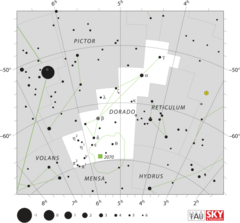Astronomy:Theta Doradus
| Observation data Equinox J2000.0]] (ICRS) | |
|---|---|
| Constellation | Dorado |
| Right ascension | 05h 13m 45.45627s[1] |
| Declination | −67° 11′ 06.9351″[1] |
| Apparent magnitude (V) | +4.82[2] |
| Characteristics | |
| Spectral type | K2/3 III CNIb/II[3] |
| U−B color index | +1.38[2] |
| B−V color index | +1.28[2] |
| Astrometry | |
| Radial velocity (Rv) | +10.5±0.8[4] km/s |
| Proper motion (μ) | RA: +18.280[1] mas/yr Dec.: +38.470[1] mas/yr |
| Parallax (π) | 6.6059 ± 0.1344[1] mas |
| Distance | 490 ± 10 ly (151 ± 3 pc) |
| Absolute magnitude (MV) | −0.56[5] |
| Details | |
| Mass | 2.23[6] M☉ |
| Radius | 16[7] R☉ |
| Luminosity | 426.6[6] L☉ |
| Surface gravity (log g) | 2.5[8] cgs |
| Temperature | 4,320±59[6] K |
| Metallicity [Fe/H] | −0.16[5] dex |
| Age | 1.17[6] Gyr |
| Other designations | |
| Database references | |
| SIMBAD | data |
Theta Doradus, Latinized from θ Doradus, is a solitary[10] star in the southern constellation of Dorado. Based upon an annual parallax shift of 6.64 mas as seen from Earth, it is located around 490 light years from the Sun. With an apparent visual magnitude of +4.82,[2] the star is bright enough to be faintly visible to the naked eye.
This is an evolved orange-hued K-type giant star with a stellar classification of K2/3 III CNIb/II,[3] where the suffix indicates it is a chemically peculiar star with a strong CN band.[11] With an age of around 1.17 billion years,[6] it has an estimated 2.23[6] times the mass of the Sun and has expanded to about 16[7] times the Sun's radius. It is radiating 426.6 times the solar luminosity from its photosphere at an effective temperature of 4,320 K.[6]
Naming
In Chinese caused by adaptation of the European southern hemisphere constellations into the Chinese system, 夾白 (Jiá Bái), meaning White Patches Attached, refers to an asterism consisting of θ Doradus and α Reticuli. Consequently, θ Doradus itself is known as 夾白一 (Jiá Bái yī, English: the First Star of White Patches Attached.)[12]
References
- ↑ 1.0 1.1 1.2 1.3 1.4 Brown, A. G. A. (August 2018). "Gaia Data Release 2: Summary of the contents and survey properties". Astronomy & Astrophysics 616: A1. doi:10.1051/0004-6361/201833051. Bibcode: 2018A&A...616A...1G. Gaia DR2 record for this source at VizieR.
- ↑ 2.0 2.1 2.2 2.3 Cousins, A. W. J.; Stoy, R. H. (1962), "Photoelectric magnitudes and colours of Southern stars", Royal Observatory Bulletin 64: 103, Bibcode: 1962RGOB...64..103C.
- ↑ 3.0 3.1 Houk, Nancy (1979), Michigan catalogue of two-dimensional spectral types for the HD stars, 1, Ann Arbor, Michigan: Dept. of Astronomy, University of Michigan, Bibcode: 1978mcts.book.....H.
- ↑ de Bruijne, J. H. J.; Eilers, A.-C. (October 2012), "Radial velocities for the HIPPARCOS-Gaia Hundred-Thousand-Proper-Motion project", Astronomy & Astrophysics 546: 14, doi:10.1051/0004-6361/201219219, A61, Bibcode: 2012A&A...546A..61D.
- ↑ 5.0 5.1 Flynn, C.; Mermilliod, J.-C. (October 1991), "On the DDO absolute magnitudes of K giants", Astronomy and Astrophysics 250 (2): 400–406, Bibcode: 1991A&A...250..400F.
- ↑ 6.0 6.1 6.2 6.3 6.4 6.5 6.6 Luck, R. Earle (September 2015), "Abundances in the Local Region. I. G and K Giants", The Astronomical Journal 150 (3): 23, doi:10.1088/0004-6256/150/3/88, 88, Bibcode: 2015AJ....150...88L.
- ↑ 7.0 7.1 Pasinetti Fracassini, L. E.; Pastori, L.; Covino, S.; Pozzi, A. (February 2001), "Catalogue of Apparent Diameters and Absolute Radii of Stars (CADARS)", Astronomy and Astrophysics 367: 521–524, doi:10.1051/0004-6361:20000451, Bibcode: 2001A&A...367..521P.
- ↑ Zboril, M. (July 2009), "Metallicity and photospheric abundances in field GKM giants and dwarfs", Monthly Notices of the Royal Astronomical Society 397 (1): 335–340, doi:10.1111/j.1365-2966.2009.14917.x, Bibcode: 2009MNRAS.397..335Z.
- ↑ "tet Dor". SIMBAD. Centre de données astronomiques de Strasbourg. http://simbad.u-strasbg.fr/simbad/sim-basic?Ident=tet+Dor.
- ↑ Eggleton, P. P.; Tokovinin, A. A. (September 2008), "A catalogue of multiplicity among bright stellar systems", Monthly Notices of the Royal Astronomical Society 389 (2): 869–879, doi:10.1111/j.1365-2966.2008.13596.x, Bibcode: 2008MNRAS.389..869E.
- ↑ Gray, C. Richard O.; Corbally, J. (2009), Stellar Spectral Classification, Princeton University Press, p. 278, ISBN 978-0691125114.
- ↑ (in Chinese) AEEA (Activities of Exhibition and Education in Astronomy) 天文教育資訊網 2006 年 7 月 27 日
 |


